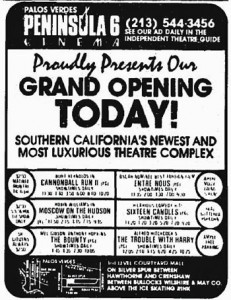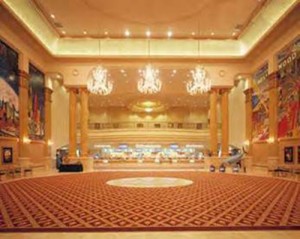Amid the decades old family legacies and corporate conglomerates, that dominate the Southern California cinema landscape, there exists a somewhat quirky chain that has managed to operate outside theatre industry norms for twenty five years.
Founded in 1984, Krikorian Theatres were inspired in to existence via a father’s movie going frustrations. George Krikorian, a successful real estate developer and thoroughbred racehorse owner, had noted a lack of local cinema options, while attempting to take his children to the movies in the Palos Verdes Peninsula area. Recognizing a potential business opportunity, Krikorian set about launching his own theatre, in what is now known as the “Avenue of the Peninsula” shopping center.
.
The Peninsula 6 proved highly successful within a few years of opening, warranting a three screen addition and sparking the idea of launching a full fledged chain. Sticking to his alternative market approach, Krikorian focused on areas that had been ignored by traditional theatre operators, often targeting struggling retail properties that were looking to redevelop. By the early 90’s, the burgeoning chain had grown to seven theatres, primarily located in secondary markets, such as Hemet, Lake Elsinore, and Diamond Bar. While modeled within the standard cinema design of the time, each of Krikorian’s theatres featured peculiar flourishes, such as unadvertised THX certification and under built box offices, partnered with over sized concession stands. Marketed as being luxurious wonders, that served under screened communities, most of Krikorian’s venues struggled with both inefficient designs and questionable locations.
Falling well short of the success Krikorian experienced with his first site, the entire chain was sold to Regal Cinemas, in 1996, for $28 million and stock options. Accounts vary, as to why the chain was sold; Krikorian citing the emergence of stadium seating and a desire to launch a more viable line of theatres; insiders noting Mr. Krikorian’s mid 90’s divorce settlement as being the true cause. In any case, Krikorian’s sale proved to be an acute business move, as the original theatres didn’t survive much longer under Regal; today, only the La Mirada location remains in operation as a cinema.
By the new millennium, Krikorian had re launched his chain, as the more upscale and, potentially, commercially viable, Krikorian Premiere Theatres. While still retaining an attraction to redevelopment sites, the choices were a bit less adventurous, building in San Clemente, Downey, Redlands, and Monrovia. Additionally, Krikorian initiated a much more ambitious advertising campaign for the new chain, utilizing large format newspaper block ads, regular spots on FM talk radio (including a promo cut by Howard Stern), and even television commercials for new theatre openings; all relatively unprecedented, in the normally frugal world of cinema marketing. The retooled chain’s theatres also began to feature a flair for extravagance, culminating in the company’s “Metroplex” concept. The first “Metroplex” being built as part of the Buena Park Mall remodel and continuing on in to the company’s Vista, Corona, and Pico Rivera locations.
.
The “Metroplex” concept involved modern megaplexes that were designed with a classic cinema style. Featuring ornate lobbies, commissioned artwork, and top of the line amenities, the “Metroplex” theatres were intended to provide all of the conveniences of modern cinemas, while adding the luxurious experience of golden era movie palaces. However, true to the company’s tradition of missteps, the “Metroplexes” also suffered from a host of logistical problems and over indulgence. Aesthetically pleasing, but inefficient, the new theatres’ facilities struggled to serve movie goers effectively. Special touches, like Buena Park’s rooftop spotlights, went to waste, as plans had failed to consider functional issues (Buena Park’s alleged “7 mile” spotlight range was reduced to a barely visible glow against a well lit urban landscape). Luxury features, such as heavily promoted martini lounges, failed to materialize at all. And, much like Krikorian’s original chain, the choice of alternative sites resulted in uniformly disappointing attendance levels. While more pompous and grandiose than it’s predecessor, Krikorian Premiere Theatres proved to be strangely similar to Krikorian Theatres.
.
Despite Krikorian’s twenty-five years of missteps and misconceived grandeur, the chain has managed to survive, within a market and time period that have seen few other theatre operators remain fully intact. An eccentric little company, at odds with industry and business norms, that somehow continues on.
Tags: 3 Comments




3 responses so far ↓
Some corrections to the article above.
First of all, the majority of the houses in the original Krikorian circuit did NOT have lackluster attendance as you indicated. Having worked for Mann, UA and Syufy, (as well as 2 locations in the Krikorian chain), I can tell you that the busy Krikorians then were comparable to their competitiors. All circuits have their slow ponies, but Peninsula 9 was a powerhouse, eclipsed only by Whitwood 10 when it opened. El Cajon was also very, very busy–and set attendance records Thanksgiving 1991.
Secondly, I’m not sure what this business is about inadequate box offices? Perhaps you only went to one location. The standard for the old chain were modern, spacious, walk-in 3-station rooms complete with the latest Theatron Data System computers, PA systems, neon signage, the works. They weren’t small or skimpy at all.
As for your remarks about the new Krikorian chain, I can’t comment. I’ve never been to one.
Lastly, the original chain was also called Krikorian Premiere Theatres.
The old Krikorians couldnt have been too successful or they would still be around. The new theaters are nice but like was mentioned the locations are questionable.
No, they would not still be around. Mann, UA, AMC, etc.–they all got rid of most of their old multiplexes. If you read the article, it explains very clearly that the old circuit was sold because of a divorce among the owners. It was also a smart business decision–unloading non-megaplex locations right before they lost their value.